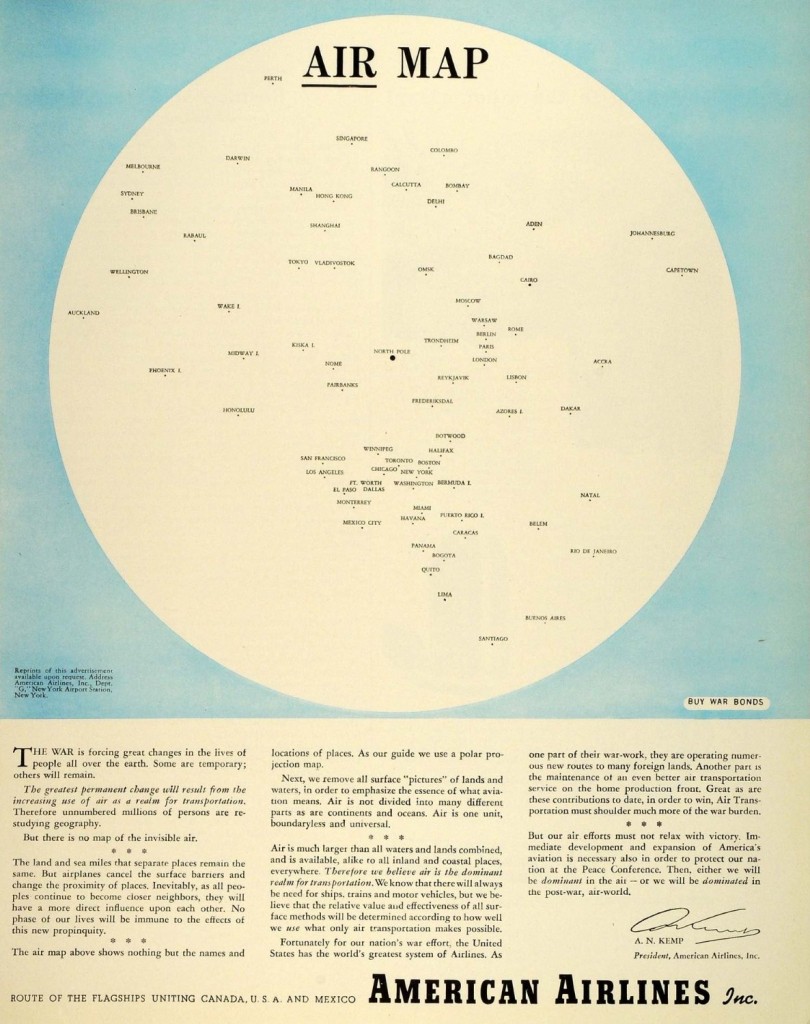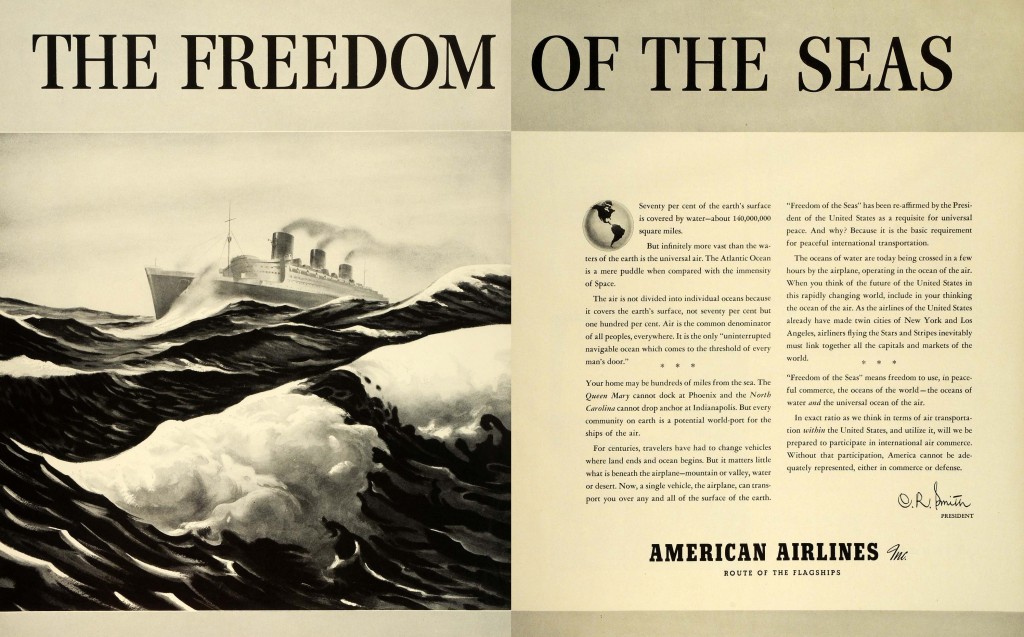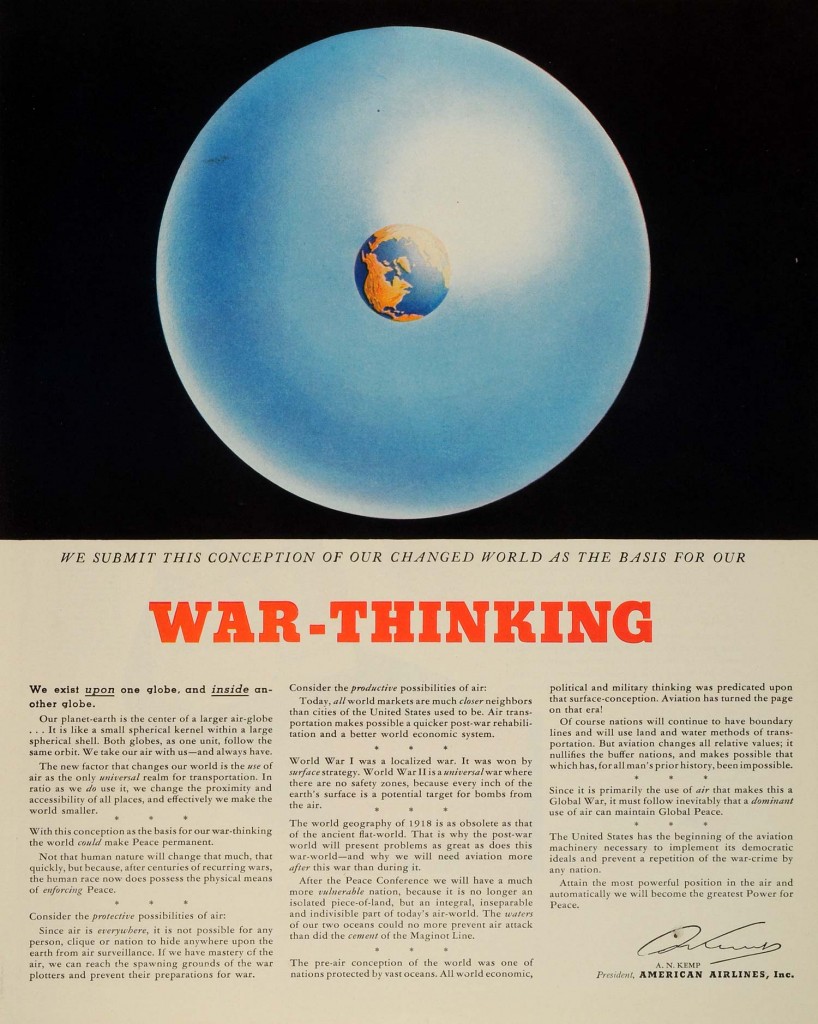War-Thinking /> Originally published in aCCeSsions No.2 , 2016
“We exist upon one globe and inside another globe.”
1943. An illustrator produces an image for an American Airlines, Inc. advertisement entitled
War-Thinking . In the ad, two nested spheres of Earth and its atmosphere sit in a starless black field. The earth is a contracted cobalt pupil. The pale blue iris-atmosphere surrounding it is far too thick—if Earth were the size of a classroom globe, the atmosphere would have the relative depth of a sheet of plastic wrap.
The ad is one in a series which also includes Air Map (1943), an image of global cities rendered as a sequence of points and set within a featureless white circle, evacuated from topography and political borders, and The Freedom of the Seas (1941), a two-page spread of an ocean liner in rough waters. The second ad’s title and editorial-style copy argue that Dutch jurist Hugo Grotius’s 1609 legal justification of the seas as a common resource, made in support of the unhindered exertion of state power through trade, be extended to the “ocean of air” now accessible by aviation. Each advertisement’s copy is signed, Air Map and
War-Thinking bearing the signature of American Airlines’ wartime president A.N. Kemp.

American Airlines, Inc., "Air Map," 1943.
In
War-Thinking , the motif of the single eye is abstracted into the proportions of Earth to atmosphere, while retaining its association with the power of vision. The image encourages the viewer to occupy both an “inward” speculative-orbital position of American biopower, mirrored in air surveillance’s expansion of spatial control and police powers, and an “outward” point of view from the pupil-Earth’s contracted surface, in parallel with the expanding technological reach of states during World War II. Taken together, the image and text capture and collapse the ambitions and attendant anxieties produced by rapidly expanding capacities to observe and gather data on Earth’s surface from above, prefiguring further advancements in flight and imaging technology.

American Airlines, Inc., "The Freedom of the Seas," 1941.
At the time, the potential of “the overview effect” and the “interiorization” of the global—as described by Anselm Francke in conversation with Diedrich Diederichsen and Ana Teixeira Pinto for e-flux journal—in effecting a lasting psychological reconfiguration was still an open question. American airborne radar, with its capacity to extend vision, came into use in the early 1940s, and the Gloster Meteor, the first jet-powered fighter aircraft, was in development. H2S ground scanning airborne radar was first used in 1943. American Airlines launched its first domestic freight service in 1944 and began offering international transatlantic flights the following year. Robert Salter’s RAND proposal for a “Preliminary Design of an Experimental World-Circling Spaceship,” the US Government’s earliest proposal for a satellite reconnaissance system, was to appear a year later in 1946. These imaging systems would soon produce the first partial image of Earth taken from a V-2 missile that same year, and the first full-view color photograph of Earth taken by the Department Of Defense Gravity Experiment (DODGE) satellite in 1967.
“We submit this conception of our changed world…”
But even as
War-Thinking references the upcoming “Peace Conference” and espouses its potential to bring about the recognition of a shared “air-globe,” the advertisement’s text is a justification of the global expansion of American trade and police power. Its argument for “peace” remains predicated on airborne military enforcement and global air surveillance, Earth and atmosphere functioning together as a panopticon-in-reverse. And while A.N. Kemp writes that air, as “the only universal realm for transportation,” produces a “conception of our changed world” and frames within it a collective “human race” connected by new proximity and accessibility, in an interview with the Pittsburgh Courier from the same year, Kemp states, “I don’t believe that Negroes will be used as pilots in the immediate world of post-war aviation.”1 Furthermore, prior to his presidency at American Airlines, Kemp was the president of Pacific Mutual Life Insurance, opening up questions of how an actuarial perspective on risk and the valuation of life may have influenced his insistence on the import of air’s universality, at least in the approval of this particular wartime ad copy.

American Airlines, Inc., "
War-Thinking ," 1943.
Considering the contemporary expansion of biopolitical control and the further financialization of life in interlinked projects such as “quantified Earth” and the logic of ecosystem services,
War-Thinking retains imaginative potential for the present. The implementation of dual-use technologies for data-gathering, quantification, and measurement in combating climate change, including the widely expanded field of remote sensing satellites and other aerial systems, such as the use of airborne LIDAR in quantifying the value of carbon in tropical forests or scanning protest sites, is a reminder that weather observation and reconnaissance are historically co-located activities. For good reason, then, the anxieties of
War-Thinking ’s atmospheric geopolitics and “opportunities” remain—though not without the generative potential suggested by its subtext: a reflection upon the commons.
Remember that dream you had in college about holding your younger self as she cried? She was all alone on some playground in Belgium sobbing. She was so devastated about what could have been anything and everything, which is an emotional state we’ve been grappling with for what seems like forever. So instinctually we rushed to young kytana and embraced her with a fierce tightness. We then began to cry just as hard as she was because we intrinsically understood how she was feeling. The dream began to breakdown at this point but I think we said something like ”I’m right here, I see you and things will get better” into her brightly barrette covered pigtails because we knew that’s what we would have wanted to hear in that very moment.
So, I write this letter in hopes of doing the same thing we did for our younger dream self. I’m here kytana, I see you and things will get better. I don’t have to recount to you some of the things we’ve fought through to get to this point in life. They are times we rather not dwell on but I am here to tell you that we will deal with the 2020 COVID-19 Pandemic the same way we’ve always have and emerge scathed but standing.
You’re going to find solace and renewed energy in the foundational sandbox that is your collages. Your intent will still be focused on creating alternate realities in where the black female form can be a symbol of exploration, knowledge, peace, ingenuity, and innovation. And on the border scope, you will still be thinking of ways to affirm that the essence of Afrofuturism is attainable. Our Pan-African Diaspora just has to continue to dream big, cherish the planet, and look up at the stars of the universe for the courage to be more than a stereotype.
I’d be full shit if I said this was the end of our trials and tribulations for both us and humanity, but just remember to continue to dream wonderful lush worlds in spite of everything.
2020 is not your end and nor is it the worlds.
Yours wholeheartedly,
Future Kytana
P.S Here is a song recommendation to ease your mind. Is it too cheeky to say I already know you’re going to love it?
“ Buttermilk “ by Beau Diako & Emawk.
 American Airlines, Inc., "Air Map," 1943.
American Airlines, Inc., "Air Map," 1943.
 American Airlines, Inc., "The Freedom of the Seas," 1941.
American Airlines, Inc., "The Freedom of the Seas," 1941.
 American Airlines, Inc., " War-Thinking ," 1943.
American Airlines, Inc., " War-Thinking ," 1943.